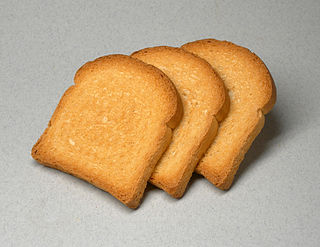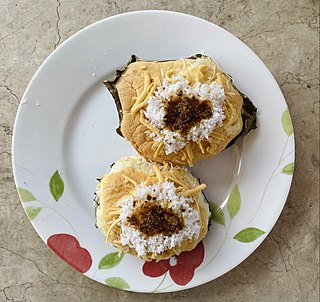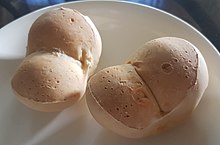
Cake is a flour confection made from flour, sugar, and other ingredients and is usually baked. In their oldest forms, cakes were modifications of bread, but cakes now cover a wide range of preparations that can be simple or elaborate and which share features with desserts such as pastries, meringues, custards, and pies.

A pancake, also known as hotcake, griddlecake, or flapjack, is a flat cake, often thin and round, prepared from a starch-based batter that may contain eggs, milk, and butter, and then cooked on a hot surface such as a griddle or frying pan. It is a type of batter bread. Archaeological evidence suggests that pancakes were probably eaten in prehistoric societies.

A churro (Spanish pronunciation:[ˈtʃuro], Portuguese pronunciation:[ˈʃuʁu] is a type of fried dough from Spanish and Portuguese cuisine, made with choux pastry dough piped into hot oil with a piping bag and large closed star tip or similar shape. They are also found in Latin American cuisine, Philippine cuisine and in other areas that have received immigration from Spanish and Portuguese-speaking countries, especially in France and the Southwestern United States.

A rusk is a hard, dry biscuit or a twice-baked bread. It is sometimes used as a teether for babies. In some cultures, rusk is made of cake, rather than bread: this is sometimes referred to as cake rusk. In the UK, the name also refers to a wheat-based food additive.

The ensaïmada is a pastry product from Mallorca, Balearic Islands, Spain, commonly found in southwestern Europe, Latin America and the Philippines.

A buñuelo (Spanish:[buˈɲwelo], alternatively called boñuelo, bimuelo, birmuelo, bermuelo, bumuelo, burmuelo, or bonuelo, is a fried dough fritter found in Spain, Latin America, and other regions with a historical connection to Spaniards, including Southwest Europe, the Balkans, Anatolia, and other parts of Asia and North Africa. Buñuelos are traditionally prepared at Christmas. It will usually have a filling or a topping. In Mexican cuisine, it is often served with a syrup made with piloncillo.

Bibingka is a type of baked rice cake in Filipino cuisine that is cooked in a terracotta oven lined with banana leaves and is usually eaten for breakfast or as merienda, especially during the Christmas season. It is also known as bingka in the Visayas and Mindanao islands.

Biscocho, also spelled biskotso, refers to various types of Filipino twice-baked breads, usually coated with butter and sugar, or garlic in some cases. Biscocho is most strongly associated with the versions from the province of Iloilo, although it actually exists nationwide in various forms. It is also known as biscocho duro, machacao, or matsakaw. It is also historically known as pan de caña.

Pan de coco, literally "coconut bread" in Spanish, is a Filipino rich sweet roll that uses sweetened shredded coconut meat (bukayo) as filling.

Pandesal, also known as Pan de sal is a staple bread roll in the Philippines commonly eaten for breakfast. It is made of flour, yeast, sugar, oil, and salt.

Puto is a Filipino steamed rice cake, traditionally made from slightly fermented rice dough (galapong). It is eaten as is or as an accompaniment to a number of savoury dishes. Puto is also an umbrella term for various kinds of indigenous steamed cakes, including those made without rice. It is a sub-type of kakanin.

Pionono describes different sweet or savory pastries from Granada, Spain, the Philippines, South America, and the Caribbean. They are named after Pope Pius IX's name in Italian, Pío Nono.

Sponge cake is a light cake made with eggs, flour and sugar, sometimes leavened with baking powder. Some sponge cakes do not contain egg yolks, like angel food cake, but most of them do. Sponge cakes, leavened with beaten eggs, originated during the Renaissance, possibly in Spain. The sponge cake is thought to be one of the first non-yeasted cakes, and the earliest attested sponge cake recipe in English is found in a book by the English poet Gervase Markham, The English Huswife, Containing the Inward and Outward Virtues Which Ought to Be in a Complete Woman (1615). Still, the cake was much more like a cracker: thin and crispy. Sponge cakes became the cake recognised today when bakers started using beaten eggs as a rising agent in the mid-18th century. The Victorian creation of baking powder by English food manufacturer Alfred Bird in 1843 allowed the addition of butter to the traditional sponge recipe, resulting in the creation of the Victoria sponge. Cakes are available in many flavours and have many recipes as well. Sponge cakes have become snack cakes via the Twinkie.

Mexican breads and other baked goods are the result of centuries of experimentation and the blending of influence from various European baking traditions. Wheat, and bread baked from it, was introduced by the Spanish at the time of the Conquest. The French influence in Mexican Bread is the strongest. From the bolillo evolving from a French baguette to the concha branching out from a French brioche even the terminology comes from France. A baño maría, meaning a water bath for a custard type budín or bread pudding comes from the French word bain marie. While the consumption of wheat has never surpassed that of corn in the country, wheat is still a staple food and an important part of everyday and special rituals. While Mexico has adopted various bread styles from Europe and the United States, most of the hundreds of varieties of breads made in the country were developed here. However, there is little to no baking done in Mexican homes; instead, Mexicans have bought their baked goods from bakeries since the colonial period.

Concha, plural conchas, is a traditional Mexican sweet bread roll with similar consistency to a brioche. Conchas get their name from their round shape and their striped, seashell-like appearance. A concha consists of two parts, a sweetened bread roll, and a crunchy topping ; With the most common crunchy topping flavors being chocolate, vanilla, and strawberry. Conchas are commonly found throughout Mexico in panaderias. They can now also be found in grocery stores and bakeries across the United States.

Pinagong is a dense bread roll from the Philippines made with all-purpose flour, milk, and salt. It is a variant of pan de monja (monáy) distinguished primarily by its shape and the more complex pattern of scoring on top. The name means "made into a turtle", from Tagalog pagong ("turtle").

Putok or star bread is a dense bread roll from the Philippines made with all-purpose flour, milk, and salt. It is typically dusted with coarse white sugar. It is a variant of pan de monja (monáy) distinguished primarily by the crown or star-shaped top of the bread resulting from a cross-shaped cut on the dough prior to baking. The name literally means "explosion" or "fissure" in Tagalog.

Pan de regla, also known as kalihim, is a Filipino bread with a characteristically bright red, magenta, or pink bread pudding filling made from the torn pieces of stale bread mixed with milk, sugar, eggs, butter, and vanilla. It is known by a wide variety of local names, most of which are humorous. It is a common cheap bread sold in bakeries in the Philippines. It is usually eaten for merienda.

Señorita bread, also known as Spanish bread or pan de kastila, is a Filipino bread roll characteristically oblong or cylindrical in shape with a traditional sweet filling made of breadcrumbs, butter or margarine, and brown sugar. It is usually yellowish in color due to the use of eggs and butter. The exterior is sprinkled with breadcrumbs.























